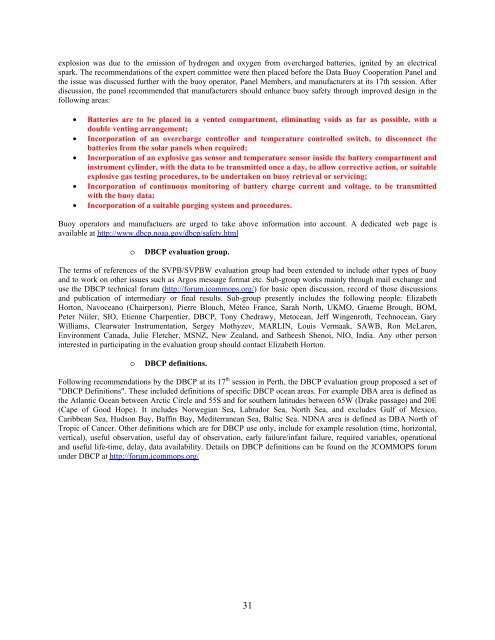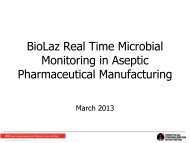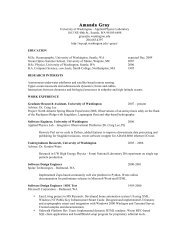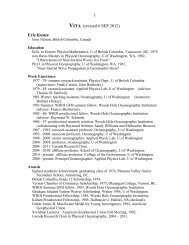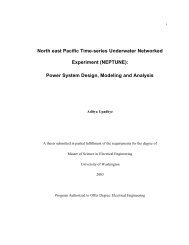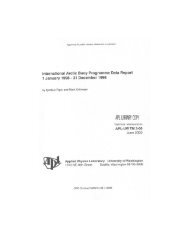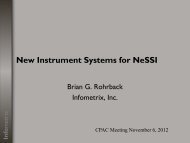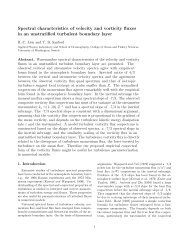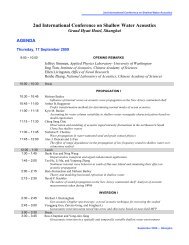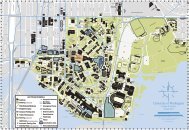International Arctic Buoy Programme (IABP) Marine Environmental ...
International Arctic Buoy Programme (IABP) Marine Environmental ...
International Arctic Buoy Programme (IABP) Marine Environmental ...
You also want an ePaper? Increase the reach of your titles
YUMPU automatically turns print PDFs into web optimized ePapers that Google loves.
explosion was due to the emission of hydrogen and oxygen from overcharged batteries, ignited by an electricalspark. The recommendations of the expert committee were then placed before the Data <strong>Buoy</strong> Cooperation Panel andthe issue was discussed further with the buoy operator, Panel Members, and manufacturers at its 17th session. Afterdiscussion, the panel recommended that manufacturers should enhance buoy safety through improved design in thefollowing areas:• Batteries are to be placed in a vented compartment, eliminating voids as far as possible, with adouble venting arrangement;• Incorporation of an overcharge controller and temperature controlled switch, to disconnect thebatteries from the solar panels when required;• Incorporation of an explosive gas sensor and temperature sensor inside the battery compartment andinstrument cylinder, with the data to be transmitted once a day, to allow corrective action, or suitableexplosive gas testing procedures, to be undertaken on buoy retrieval or servicing;• Incorporation of continuous monitoring of battery charge current and voltage, to be transmittedwith the buoy data;• Incorporation of a suitable purging system and procedures.<strong>Buoy</strong> operators and manufactuers are urged to take above information into account. A dedicated web page isavailable at http://www.dbcp.noaa.gov/dbcp/safety.htmlo DBCP evaluation group.The terms of references of the SVPB/SVPBW evaluation group had been extended to include other types of buoyand to work on other issues such as Argos message format etc. Sub-group works mainly through mail exchange anduse the DBCP technical forum (http://forum.jcommops.org/) for basic open discussion, record of those discussionsand publication of intermediary or final results. Sub-group presently includes the following people: ElizabethHorton, Navoceano (Chairperson), Pierre Blouch, Météo France, Sarah North, UKMO, Graeme Brough, BOM,Peter Niiler, SIO, Etienne Charpentier, DBCP, Tony Chedrawy, Metocean, Jeff Wingenroth, Technocean, GaryWilliams, Clearwater Instrumentation, Sergey Mothyzev, MARLIN, Louis Vermaak, SAWB, Ron McLaren,Environment Canada, Julie Fletcher, MSNZ, New Zealand, and Satheesh Shenoi, NIO, India. Any other personinterested in participating in the evaluation group should contact Elizabeth Horton.o DBCP definitions.Following recommendations by the DBCP at its 17 th session in Perth, the DBCP evaluation group proposed a set of"DBCP Definitions". These included definitions of specific DBCP ocean areas. For example DBA area is defined asthe Atlantic Ocean between <strong>Arctic</strong> Circle and 55S and for southern latitudes between 65W (Drake passage) and 20E(Cape of Good Hope). It includes Norwegian Sea, Labrador Sea, North Sea, and excludes Gulf of Mexico,Caribbean Sea, Hudson Bay, Baffin Bay, Mediterranean Sea, Baltic Sea. NDNA area is defined as DBA North ofTropic of Cancer. Other definitions which are for DBCP use only, include for example resolution (time, horizontal,vertical), useful observation, useful day of observation, early failure/infant failure, required variables, operationaland useful life-time, delay, data availability. Details on DBCP definitions can be found on the JCOMMOPS forumunder DBCP at http://forum.jcommops.org/31


